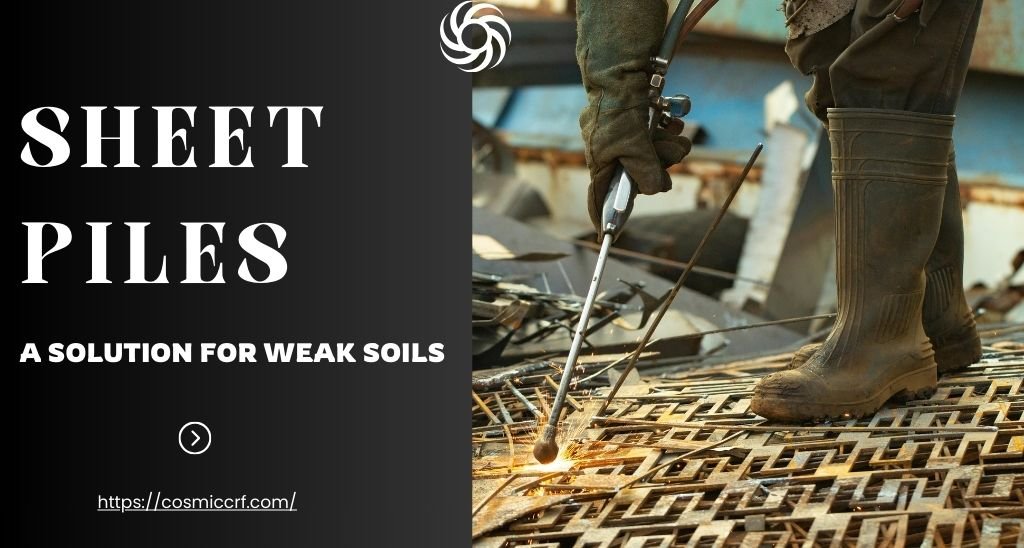Soft ground slows down everything. Excavation takes longer. Foundations need more work. Equipment sinks. Schedules slip.
In many projects, poor soil feels like a losing battle before anything even begins. You deal with constant movement, sudden water ingress, and low load-bearing strength.
Here’s where sheet piles come in.
When used early and designed right, they make construction possible even in soil you would normally avoid.
Sheet Piles Offer Immediate Earth Retention in Weak Soils
Soft soils collapse when cut. That creates unsafe excavations and complicates formwork or reinforcement setups.
When you drive sheet piles before digging, you create a strong vertical wall that holds soil in place from the start. It lets you excavate deeper without the sides caving in. This helps teams move faster without needing complex shoring.
In marshy or silty zones, the sheets stay stable even when traditional supports would settle or shift. The piles hold their shape and create a defined, reliable edge to build against.
They Minimize Ground Movement Around Critical Zones
Excavating in poor soil often affects everything nearby. The deeper you go, the more the surrounding ground starts to shift.
Sheet piles reduce that movement by creating a stiff barrier between the excavation and the rest of the site. That helps protect existing buildings, utilities, or roadways running close to the dig.
For projects near hospitals, transmission lines, or heritage buildings, even small shifts can trigger major concerns.
Sheet piles give you a physical way to reduce that risk, keeping the surrounding zone stable while you work inside it.
Water Control Gets Easier With a Sheet Pile System
Many poor soil types also come with water trouble. You might have high groundwater, perched water tables, or loose fill that soaks fast and holds water unpredictably.
Interlocked sheet piles act like a cutoff wall. When driven deep enough, they cut off groundwater pathways and help isolate the excavation zone. This makes dewatering simpler and more focused.
In coastal or river-adjacent projects, sheet piles also help keep tidal or floodwater from entering the site during active construction. That containment becomes a foundation for more accurate planning and safer work.
They Create a Working Platform in Soft Ground
Poor soil does not support heavy equipment. Wheels sink. Cranes tilt. Deliveries get delayed because trucks can’t reach the site.
Sheet piles help here too. When you build a closed pile box or drive them in patterns with tie rods and wales, you can create enclosed work zones. These zones can then be backfilled with stronger fill or compacted material to create a working platform.
This is common in bridge abutment construction over rivers or in temporary structures used in wetland development. The piles let you define a patch of solid ground in the middle of soft terrain.
They Adapt to Changing Soil Layers on The Same Site
Many sites with poor surface soil also show variation in depth. A layer of clay might sit on top of sandy fill, with waterlogged silt below that.
Sheet piles handle this layering better than most cast systems.
You can choose a pile profile that adjusts to depth, stiffness, or interlock requirement. Driving depth can also be modified section by section based on what the bore logs reveal.
If you try to pour a concrete wall in these mixed zones, the formwork would shift and curing would become unreliable. Piles handle these variables with fewer workarounds.
They Speed Up Schedule on Unpredictable Ground
Poor soil forces many construction teams to build slowly and cautiously. Work depends on how the ground behaves that day.
Sheet piles take some of that unpredictability away. Once driven, they stay in place and define the space clearly. This lets teams follow a clearer sequence for excavation, utilities, or slab prep.
You also reduce the risk of weather delays, since sheeted walls offer protection from soil collapse during rain or water ingress. For large sites, the time saved across weeks can be significant.
Final Thoughts
Every construction team working with soft or unpredictable soil faces the same challenge: how to create stable, dry, and workable zones fast. Sheet piles solve that.
At our end, we focus on forming high-quality sheet pile profiles that match varying site needs, from tight-radius interlocks for water resistance to deep section geometry for high stiffness.
Our sheet pile systems have supported everything from marine walls to foundations in silty or reclaimed ground.
So, if your next site demands better control over poor soil, sheet piles may deserve a closer look early in planning. They don’t just support the ground, but the project itself.




